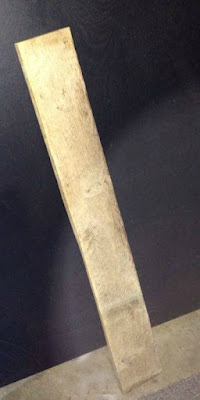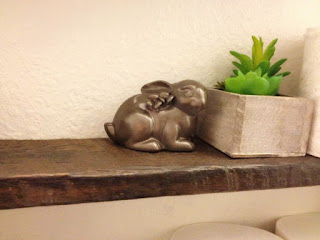John and I are not what I would consider extreme minimalists. We have watched several documentaries about minimalism, and read many articles...but we are by no means experts. We just really want to start "getting our act together" when it comes to clutter and excessive possessions. We have started applying the concept of minimalism in our home (in our own way) in order to help us reign in the chaos of 4 kids and 6 busy lives.
You can apply the concept of minimalizing into many areas of your life, but I will mainly be talking about minimalizing in the home...
The basic idea of minimalism in the home is to clear out what you have laying around your house that is unneeded, unwanted, or otherwise weighing you down. Maybe you have 2 sewing machines, so you
could choose to sell/give away/donate the one you like/use the least? Not only would you make a bit more space in your closet, but you'd also get rid of that voice in your head that says "you really need to get rid of that old thing" each time you see that extra sewing machine sitting there.
Maybe you're holding on to a lot of items (that you don't really want) because of sentimental reasons? Or maybe you're keeping a lot of things around "just in case" (like clothes that fit 10 years ago)?
In watching documentaries about minimalism, they tend to showcase very extreme cases of people who have gotten rid of almost everything they own. I'm not interested in that - I just want to make room in my life to have and do what I really want to.
For us, the appeal is not necessarily having "less things," but the benefits that come with having less things.
One fairly extreme example that we saw was a family got rid of all of their dishes and eating utensils except for 1 plate, 1 fork, and 1 glass for each family member. (All I could think was - No bowls? No spoons? What if they want to have soup?)
Another example we saw was a man who realized that he didn't need 3 pairs of shoes, so he gave away two pairs and now just owns one...which seemed to work fine for this individual, but for me, this goes against reason. One day his only pair of shoes will get a hole in it, or the sole will come off, and he will need a new pair of shoes. This might happen during the workday, or on a date. Maybe money is no object for him, but someday this will happen and he will have no choice but to pay full price for a new pair with little or no notice (and no time to watch for sales). Personally, I think that it would have made more sense for him to hold on to a second pair in reserve (or maybe even rotate between two pairs?). But I digress...
The concept is to get rid of things that YOU don't think you need. (PS- That spoon-less and bowl-less family was ok with their choices, but I need spoons for ice cream, so that won't work for me).
The idea of minimizing your home is to get rid of what you feel comfortable with, and my idea of comfortable will be different than yours.
In one of our first minimalism efforts, John and I recently decided to pare down our dishware and silverware, because we had a large amount of mis-matched items and too many of everything. We have a temperamental dishwasher, so we usually end up washing everything by hand. If it is a busy day and the dishes don't get done right away, that doesn't stop the younger kids from getting a second or third glass (each) for water throughout the day, or using bowls and serving spoons to make concoctions. Not to mention the baby bottles and sippy cups that multiply like crazy. So we could easily go from a reasonable sink-full of dishes to a major every-dish-is-now-dirty situation in a single day. Then someone (usually John) would have to do ALL (or most of) the dishes at the end of the day, and it would take a really long time.
We
considered having one "place setting" for each person in the family. My concerns were: #1- What if we have guests? #2- I often use dinner plates for other things (like defrosting chicken in the microwave) and it just wouldn't be practical to only have a few plates that I have to keep re-washing during meal prep. So we decided that we would keep 6 dinner plates, 6 saucers, 6 bowls, and 6 glasses in the cupboard (and 6 each of forks, spoons, knifes, etc in the silverware drawer). These are all from a set I got as a Christmas gift years ago, so they match (but are now discontinued). The baby doesn't use dishes or silverware yet, so this gives me a little leeway to use extras for cooking/serving. We also keep the rest of the dishes from the same set in an upper cupboard (that isn't conveniently reachable in a lazy moment of not wanting to wash dishes) in case we have dinner guests. Or if a dish breaks, we have those extras to draw from. Any other odd dishes or glasses that we used to have were donated to Goodwill.
And guess what - we have all survived for months like this, and still have plenty of dishes to use without any problem. Turns out we don't need 30 dinner plates for 5 people & a baby. If we wash the dishes after meals, it doesn't take long and we have our dishes ready for the next meal. And there is never any big pile at the end of the day.
A concern that I sometimes have about getting rid of "extras" is that items eventually will need to be replaced and (like in the single pair of shoes example I mentioned above), you will have limited options in replacing those items. I don't consider it "hoarding" to have backups of things that I will reasonably need soon. Especially if I already own them. I don't need to run out to buy a brand new printer just in case mine breaks someday, but if I rely on my printer for work or school and have a perfectly good extra one on hand, I might
consider keeping it for that reason.
If shampoo is buy 1 get 1 free, of course I won't throw out the extra bottle, because I will need it eventually.
Recently, a relative gave us a complete set of dishes that they no longer need. I hesitated to take them, because we have our system going now. But at the rate we break our dishes, it won't be long until we won't have enough from the original set to keep this going. So we've put away the "new" set of dishes for when the time comes. At that point (when I'm down to less dishes in the original set than we need), I will donate the original set and break out the "new" set.
Again, I don't have backups or extras of everything. I don't want to keep things around that I don't need, but I also don't want to be wasteful. So there are a lot of little decisions to be made.
I will be posting more about our minimalist journey every week, please let me know if you have any questions or requests!
















































